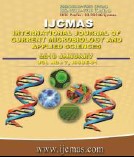


 National Academy of Agricultural Sciences (NAAS)
National Academy of Agricultural Sciences (NAAS)

|
PRINT ISSN : 2319-7692
Online ISSN : 2319-7706 Issues : 12 per year Publisher : Excellent Publishers Email : editorijcmas@gmail.com / submit@ijcmas.com Editor-in-chief: Dr.M.Prakash Index Copernicus ICV 2018: 95.39 NAAS RATING 2020: 5.38 |
Proteus species are among the commonly implicated pathogens in hospital as well as community acquired infections. They cause nosocomial sinusitis, intra-abdominal abscesses, biliary tract infection, surgical site infection, soft tissue infection and osteomyelitis. They cause significant clinical infections, which are difficult to eradicate especially from hosts with wounds, catheterization, underlying diseases and in immunocompromised states. The therapeutic obstacles during Proteus species treatment can be connected with its ability to form biofilm, antibiotic resistance due to biofilm formation leading to persistence of infections. Hence the study is undertaken to find out the ability of Proteus species isolated from different clinical samples to form biofilm and their antibiotic susceptibility pattern. Total of 150 Proteus species isolates from different clinical samples such as urine, purulent material from wounds or abscesses, ear swabs, sputum, blood or aspirates (of joint fluid, pleural fluid, ascitic fluid and pus) collected from patients suspected of bacterial infection at Victoria Hospital, Vani Vilas Hospital, attached to Bangalore Medical College and Research Institute during the period November 2012-November 2014. Samples were collected after taking informed consent from all patients and were processed. The identification of Proteus species was done using standard biochemical tests. Proteus species thus identified were screened for biofilm production by tissue culture Plate (TCP) method, tube adherence method and Congo red agar method and studied for the antibiotic susceptibility patterns by in-vitro testing by Kirby-Bauer disc diffusion method performed according to CLSI recommendations. Out of the 150 Proteus species isolated from various clinical samples, 79 were from male and 71were from females. Majority of clinical samples from which Proteus species were isolated were from pus samples (91.33%). Among them, majority were from patients of thermal burns (34 %). Proteus mirabilis was the most isolated species (57.3%). For detection of biofilm, tissue culture plate method was considered as gold standard. Among the isolates, 48% were biofilm producers and 52% were non/weak biofilm producers. Among Proteus mirabilis, 52.32% were biofilm producers whereas among Proteus vulgaris, 42.59% were biofilm producers. Among the MDR isolates, 56.5% of the isolates showed biofilm production whereas 40(43.4%) of isolates were weak/non biofilm producers. Majority of Proteus isolates showed sensitivity to Imipenem (81.1%), Piperacillin + Tazobactum (83%). Sensitivity was highest with Congo red agar method and tube adherence methods in combination (86.11%). Congo red agar method showed better specificity 82.05% than other methods. There is an increase in isolation of Proteus species from wounds than from urinary tract infections with significant numbers showing biofilm forming capability. Tissue culture plate method was considered as gold standard method for biofilm detection in the present study. Also biofilm forming Proteus species isolates showed more antimicrobial drug resistance. Multi drug resistant Proteus isolates showed more biofilm forming ability indicating need for further studies on Proteus species and their ability to form biofilms. Also further studies on better understanding of bacterial biofilm interactions at molecular level for this species are necessary as they are more frequently being implicated in chronic infections and treatment failures. Also Tube adherence method and Congo red agar method in combination proved very effective for screening biofilm forming isolates. Though PCR technique is the most accurate and specific method, it is not readily available in resource limited settings and the need of the hour is rapid, cheap, cost effective and easily available methods for detecting biofilm formation. In view of emerging drug resistance and multidrug resistance exhibited by Proteus species, periodic review and formulation of antibiotic policy are needed. Indiscriminate use of antibiotic must be discouraged and therapy should be advocated as for as possible after the culture and sensitivity reports are available.
 |
 |
 |
 |
 |